Ever wondered if the popular eucalyptus wood has a downside? Dive in to unveil the lesser-known drawbacks of this sought-after material!
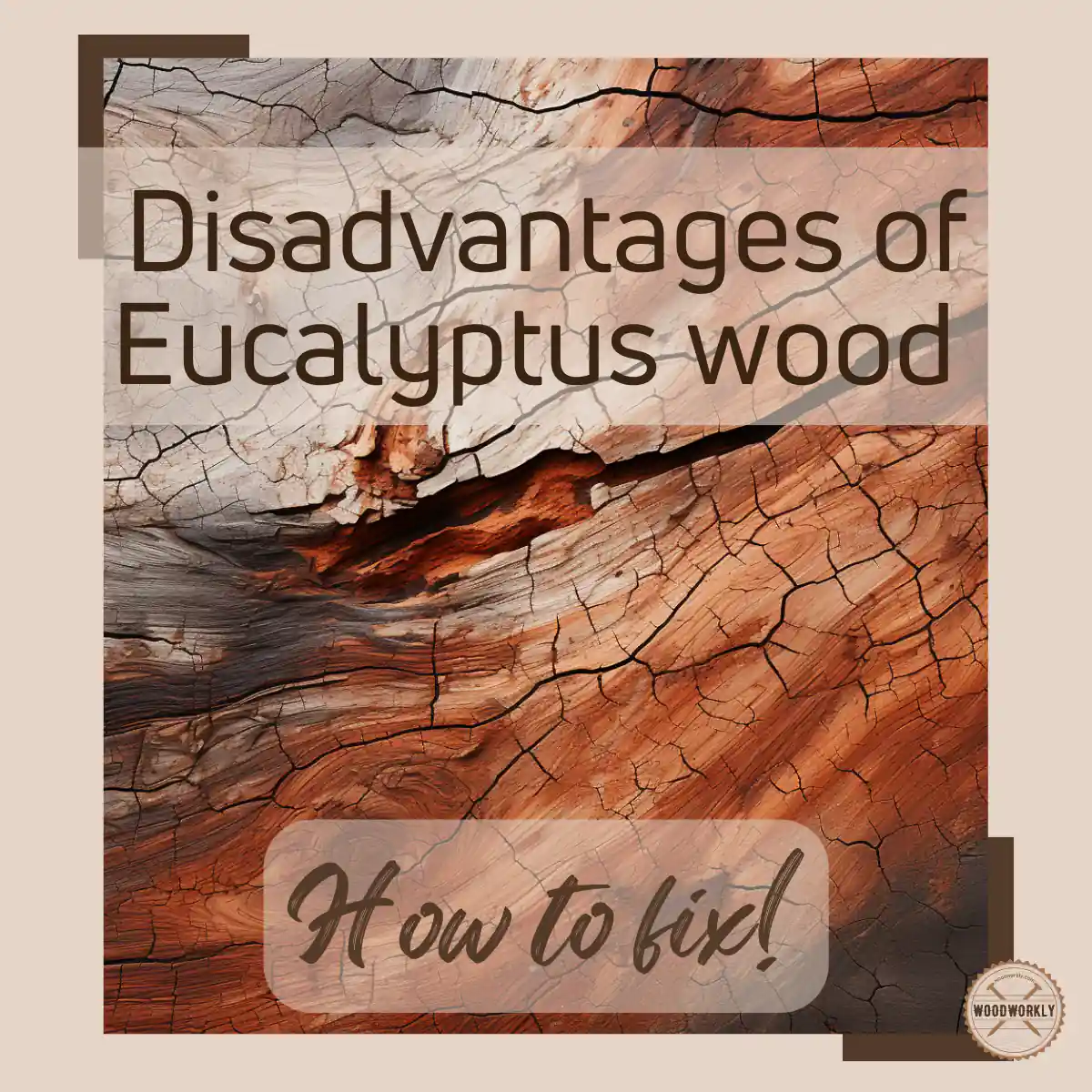
Eucalyptus wood is a popular choice when it comes to designing projects. It has lots of important hardwood qualities which are useful in construction.
When I was working with Eucalyptus wood, I was curious to know its drawbacks because I was already aware of its benefits.
I did some research and was able to find some key disadvantages of Eucalyptus wood.
Here’s the list of Eucalyptus wood disadvantages,
- Unable to handle extremely cold weather
- Susceptible to insect and pest attacks
- Prone to cracks due to temperature changes
- Less durable than teak wood
- Extensive expansions and contractions damage the wood
- Color fades over time
- Less availability
- Moderately expensive
- Need regular maintenance
- Allergic to some people
But that’s just a quick snapshot!

From this article, I’ll deeply explore each of the above Eucalyptus wood disadvantages in detail and give you the simplest method to fix those cons.
Furthermore, I’ll answer some frequently asked questions as well.
Let’s jump in!
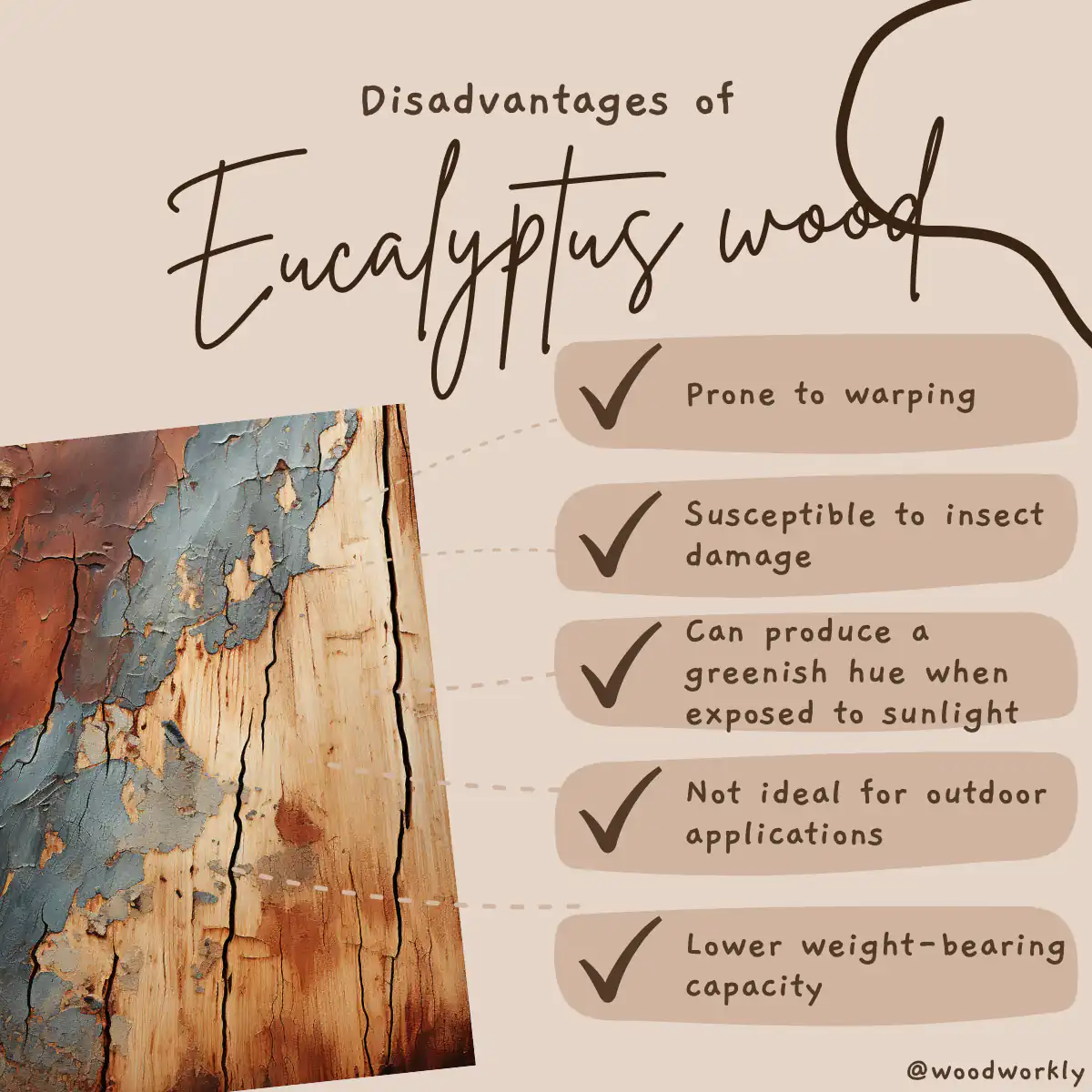
First of all, let’s have a brief look at the main advantages of Eucalyptus wood.
Advantages Of Eucalyptus Wood
- Resistant to rot and decay
- Sustainable wood
- Straight and even grain structure
- Attractive dark red over time
- High durability
- Able to use for outdoor projects
- High endurance and strength
As you can see Eucalyptus wood is filled with lots of benefits.
This is why it has become so much popular among woodworkers. It gives exceptional qualities for a significantly lower price.
So, let’s head into the key topic of Eucalyptus wood disadvantages and discuss how to fix them to get the maximum out of Eucalyptus wood.
Eucalyptus Wood Disadvantages
Let’s have a look at the disadvantages of eucalyptus in detail and how to fix them.
1. Unable to Handle Extreme Cold Weather
Extreme cold weather conditions cause Eucalyptus wood to crack and split since the wood cannot tolerate extreme cold and Eucalyptus wood fibers will lose and break under cold weather conditions.
This happens mostly for the Eucalyptus wood outdoor woodwork and furniture.
Note that, Eucalyptus wood cracks not because of the snow. Wood has good tolerance against snow but cannot tolerate coldness.
Harsh cold can break and crack the wood easily.
Therefore, better to use treated and sealed Eucalyptus wood furniture and woodwork for outside use.
When the wood is well sealed and finished, cold weather cannot affect that much towards the wood, and it won’t crack quite easily like unsealed wood.
The wood sealer works as a barrier between the Eucalyptus wood interior environment and cold weather outside.
But we cannot guarantee even after sealing and finishing the wood you can get 100% protection from the extreme cold weather since it can vary on the quality of the wood finisher or sealer.
Therefore, always choose quality wood sealing and wood finishing products.
I highly recommend you cover up or move Eucalyptus wood furniture and woodwork to somewhere safe during the winter months to keep wood from splitting and cracking.
Cold weather significantly loses the dimensional stability of the Eucalyptus wood. Especially if it is outdoor furniture.
If your Eucalyptus wood is cracked due to cold weather it can be very hard to repair the wood, but you can apply wood filler or wood putty and apply wood stain on top of that to fix the crack and restore the wood.
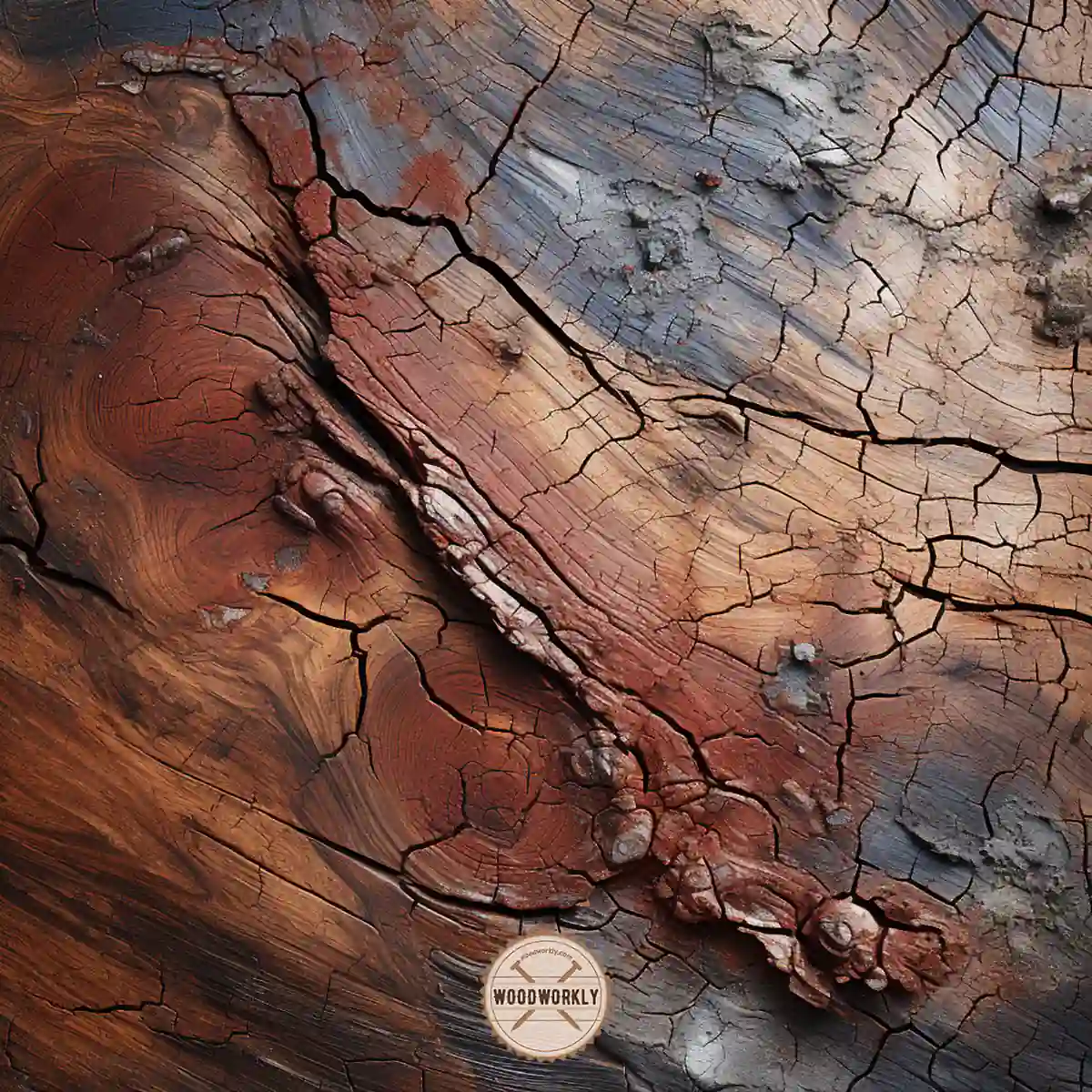
2. Susceptible To Insect and Pest Attacks
Even though Eucalyptus wood is a durable and strong hardwood, it attracts insects and pests, and they damage the wood by losing its durability.
Insect and pest attacks mostly happen when you leave Eucalyptus wood furniture untreated or unsealed.
Here are some common insects and pests that damage Eucalyptus wood,
- Eucalyptus long-horned borer is a popular pest that damages Eucalyptus wood by laying eggs inside of the wood.
- The larval form of insects damages the Eucalyptus wood by making tunnels inside the wood surface.
- Beetles attack Eucalyptus wood heavily.
- Psyllid insect species damage Eucalyptus wood by releasing sugary, sticky substances that cause fungi and mold to grow.
Eucalyptus wood interior environment is a healthy habitat for insects to lay eggs.
Pests take Eucalyptus wood as a habitat, and they widely spread all over the wood within a couple of weeks by eating the Eucalyptus wood.
You can stop insect and pest attacks only by chemically treating the Eucalyptus wood with a quality finisher like lacquer, varnish, wood stain, or finishing oil like Danish oil, teak oil, tung oil, and linseed oil.
Apply wood finisher all over the wood including small cracks and holes in the wood surface to prevent insects from going inside the wood.
Those chemical substances are harmful and able to kill insects, pests, and their eggs.
Insect and pest attacks commonly happen when you use Eucalyptus wood for outdoor woodworking projects like making garden beds and patio furniture since gardens are the kingdoms of insects.
Insects love to eat wood and you need to give proper care and regular maintenance to the Eucalyptus wood by applying a sealant regularly by not letting insects and pests damage the wood.
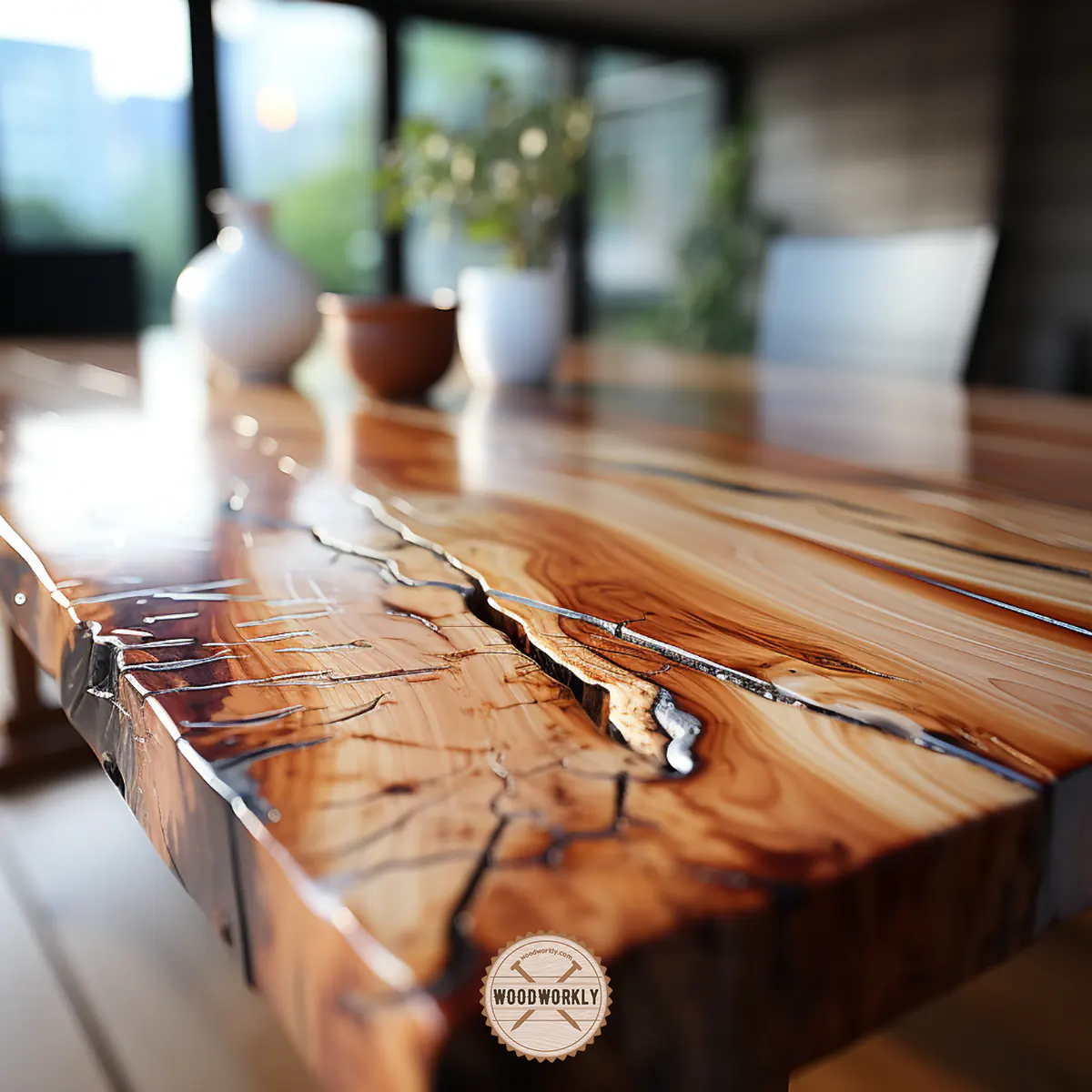
3. Prone To Crack due to Temperature Changes
Eucalyptus wood is unable to tolerate extreme temperature variations since its wood fibers expand because of the thermal expansions and shrink during cool temperature levels.
This can lead Eucalyptus wood to crack and split over time.
Eucalyptus wood is super sensitive to temperature changes.
We cannot control the wood movements with environmental change, but there is a possibility of preventing the wood from cracking by applying a proper sealer or finisher to the wood.
A quality stain or finisher is able to penetrate inside the wood fibers and make them more flexible to move along with environmental temperature changes without cracking.
Sealers and finishes can prevent Eucalyptus wood from cracking because they can soak into the wood and increase the wood’s flexibility.
If you live in an area that changes temperature drastically better not to use Eucalyptus wood for furniture and woodwork since they will lose stability and get weakened pretty quickly due to the continuous wood movements with temperature.
Repairing is also probably a waste of time and money since it is so hard to change the natural behavior of Eucalyptus wood.
4. Less Durable Than Teak Wood
Even though both Eucalyptus wood and teak wood are hardwoods, teak wood is better when it comes to high-end furniture.
This is because teak wood is stronger, harder, denser, and has higher durability than Eucalyptus wood.
Plus, teak wood has a luxurious look that adds unique beauty to the furniture and woodwork.
Overall teak wood is so much better wood in every aspect than Eucalyptus wood for any woodworking project.
The only downside of teak wood over Eucalyptus wood is the price. Teak is more expensive than Eucalyptus wood.
But when it comes to durability, teak wood furniture can last for so longer than Eucalyptus wood furniture.
Therefore, teak wood furniture needs less maintenance and no repairing cost.
Eucalyptus wood is not better than teak wood for long-term furniture.
Because you’ll have to replace Eucalyptus wood parts and repair Eucalyptus wood furniture more often. Repairing and maintenance cost lots of money and time over time.
Using teak wood for your furniture and woodwork over Eucalyptus wood is a good long-term investment.
But if you’re on a tight budget and looking for quality wood for outdoor furniture, Eucalyptus wood is a wise choice.
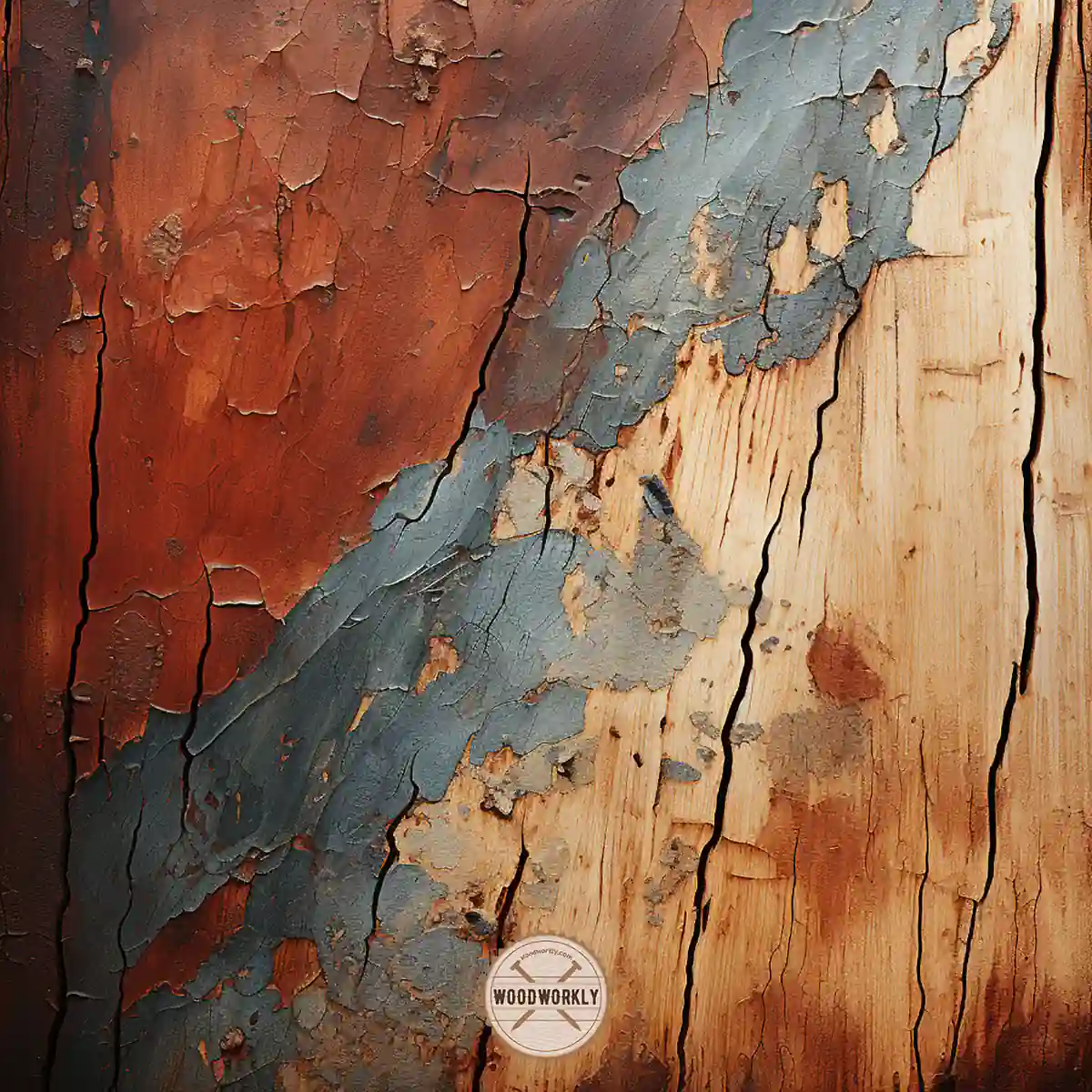
5. Extensive Expansions and Contractions Damage the Wood
Eucalyptus wood is highly sensitive to the humidity changes of the environment.
Eucalyptus wood expands under high humidity and contracts under low humidity levels.
This can cause irregular wood movement which can lead wood to crack and lose its stability.
This is how it happens,
- When the environmental humidity is high, moisture tends to penetrate the wood inside to balance the environmental humidity with the humidity inside of the wood. Because of the high moisture concentration inside the wood, the wood gets swells and expands.
- When the environmental humidity is less, moisture tends to evaporate from the wood to balance the environmental humidity with the humidity inside of the wood. Because the less moisture concentration inside the wood, the wood gets shrinks and contracts.
When environmental humidity changes drastically, extensive expansions and contractions occur in Eucalyptus wood fibers.
This can cause irregular wood movements since not every wood fiber of Eucalyptus wood expands and contracts at the same speed.
Because of these irregular movements of Eucalyptus wood, the wood gets twisted and warped easily due to humidity fluctuations.
You can prevent extensive expansions and contractions of Eucalyptus wood by stopping moisture absorptions and evaporations with outside air.
Apply a wood finisher or sealer to prevent Eucalyptus wood from dealing with outside air.
Sealer coatings work as a barrier between the wooden surface and outside air and prevent moisture from going inside the wood due to environmental humidity changes.
By applying a proper sealant, stain, or wood finish you can stop Eucalyptus wood from warping and twisting and able to increase its durability of the wood.
This is so important for the Eucalyptus wood outside furniture.
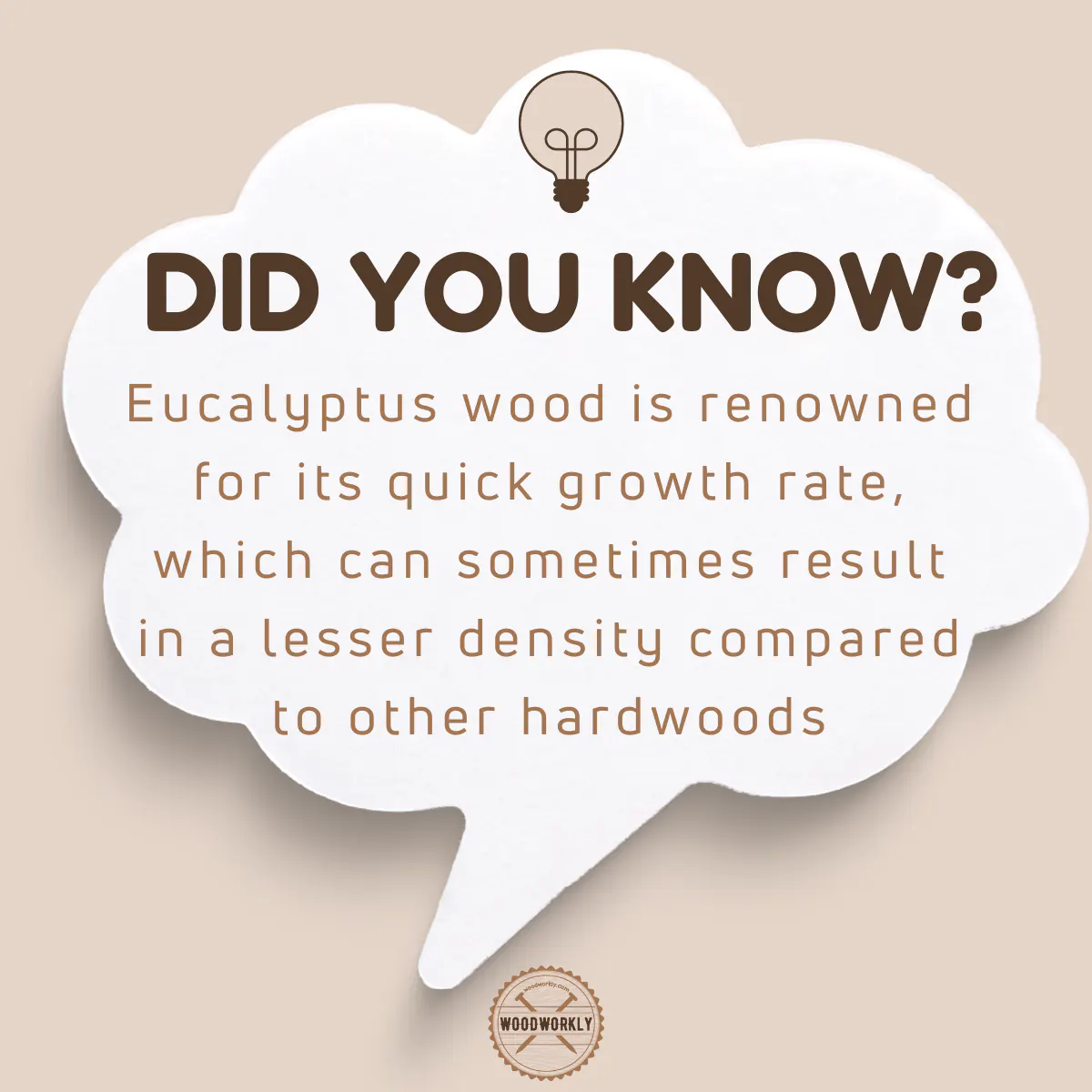
6. Color Fades Over Time
Direct sunlight fades the color of Eucalyptus wood.
The reddish-brown color of Eucalyptus wood fades to a lighter silver patina color over time because of the harmful UV radiation of the sunlight, contamination of the environment, and the natural aging process of the wood.
As we all know, Eucalyptus wood has good weather resistance. But wood is wood. Wood is highly sensitive to environmental elements like sunlight.
Therefore, applying proper sealant with UV inhibitors is a must to stop the discoloration of Eucalyptus wood.
If your Eucalyptus wood furniture of woodwork faded over time, you can bring back its original reddish-brown color by applying reddish brown color wood stain all over the wood surface.
Wood stains are able to color up the wood providing good protection to the wood from environmental elements such as moisture, UV light, and insect attacks.
Most wood stains contain UV inhibitors that help to protect the wood from discoloration by enhancing wood appearance.
Therefore, applying a proper sealer or stain before keeping Eucalyptus wood outside is a must to protect the wood from sunlight.
Direct sunlight damages the wood and gives a dull unpleasant appearance.
Or you can use windows with UV filters and cover up Eucalyptus wood furniture to protect it from direct sunlight to stop fading.
Proper caring is a must to keep Eucalyptus wood without fading.
7. Less Availability
Eucalyptus wood is not widely available in local stores. Therefore, most people tend to use online stores to buy Eucalyptus wood.
But there’s no guarantee about the wood quality since it is so difficult to purchase wood without watching them with the naked eye.
The reason for the poor availability of Eucalyptus wood is that most people tend to use it as an alternative for hardwood floors because of being cheaper than hardwoods like teak, mahogany, and Oak.
It is challenging to find Eucalyptus wood that matches your color or style at local stores.
Ordering online is the best option to find the Eucalyptus wood species that you’re looking for. But I highly recommend using branded sites for quality woods with no damage.
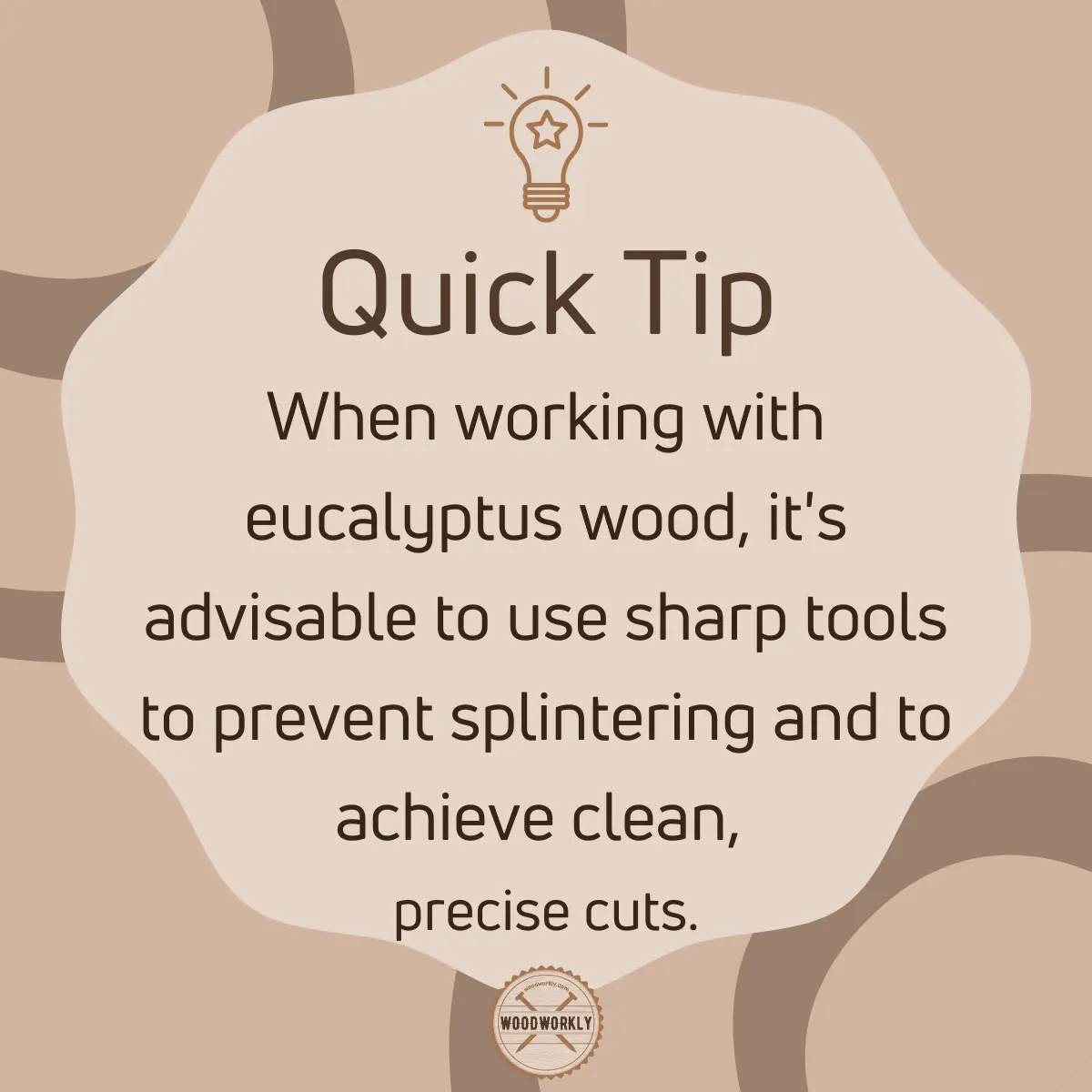
8. Moderately Expensive
Even though Eucalyptus wood is cheaper than luxurious hardwoods like teak wood, it is moderately expensive than most hardwoods that we mostly used.
Eucalyptus wood is more expensive than Bamboo, Birch, Poplar, or Alder.
But Eucalyptus wood is not expensive as teak wood, Mahogany, Hickory, and Cherry wood. that’s why it is considered a moderately expensive wood.
The main reason for Eucalyptus wood’s expensiveness because of its less availability in the local stores.
You can always find quality woods like Maple, Poplar, and Beech for a cheaper price than Eucalyptus wood because of their high availability.
Those woods also have excellent qualities or sometimes better qualities than Eucalyptus wood according to your project type.
9. Need Regular Maintenance
Eucalyptus wood needs regular maintenance to live long with proper care. Without regular maintenance Eucalyptus wood may get attacked by environmental elements such as moisture, UV light, and insect and pest attacks and its color will fade over time.
Even though Eucalyptus wood is. Hardwood is not durable as teak, hickory, mahogany, or cherry.
Therefore, giving regular maintenance with proper care is a must.
You should always apply quality sealant or finisher from time to time to keep it protected consistently.
Apply wood sealer at least once per year since once the previously applied coating fade away, would get exposed to the outside air and can get affected by elements.
Also, make sure to clean your Eucalyptus wood furniture regularly to remove dust and debris since they can damage the wood and give an unpleasant appearance to the wood.
Here are some quality wood finishers and sealants that can protect Eucalyptus wood in the long run.
- Lacquer
- Varnish
- Wood stain
- Tung oil
- Danish oil
- Linseed oil
- Teak oil
All the above finishing oils and sealants help Eucalyptus wood to improve its tolerance against environmental impacts, temperature changes, humidity changes, and much more.
They protect the wood from cracking, warping, rotting, and decaying.
If the wood somehow got rot because of poor maintenance, there’s no use in applying a wood finisher on top of the surface.
You need to remove the rotted area and restore wood with a quality product like Flexseal. That’s how you should repair rotted Eucalyptus wood.
But overall, Eucalyptus wood has good rot resistance and weather resistance.
Therefore, you can use Eucalyptus wood for an outdoor project with ease. But applying quality sealant is a must for their durability.
10. Allergic to Some People
Eucalyptus wood can be allergic to some individuals since wood sawdust and other particles can cause skin and eye irritations.
Plus, wood sawdust can cause breathing issues.
In order to reduce health effects, always wear gloves, and goggles when working with Eucalyptus wood.
Plus, use a quality dust collection pipe system to remove sawdust before it roam free in your working area since it may cause conditions like asthma, bronchitis, and toenail fungus diseases.
Some people are allergic to the oil that is released from Eucalyptus wood.
If you’re allergic to tree oil better to stay away from Eucalyptus wood since both have similar types of oils.
Furthermore, always select a well-ventilated area to work with Eucalyptus wood since good air circulation helps to reduce distinct odors that come from wood finishes and stains that use for Eucalyptus wood finishing.
Better not to use Eucalyptus wood for indoor and outdoor furniture if you feel you’re not safe around the wood.
Because there are so many better types of wood that provide the same or better features than Eucalyptus wood for the same price.
That’s it, folks. Now you have a clear in-depth idea about Eucalyptus wood disadvantages with all the relevant solutions.
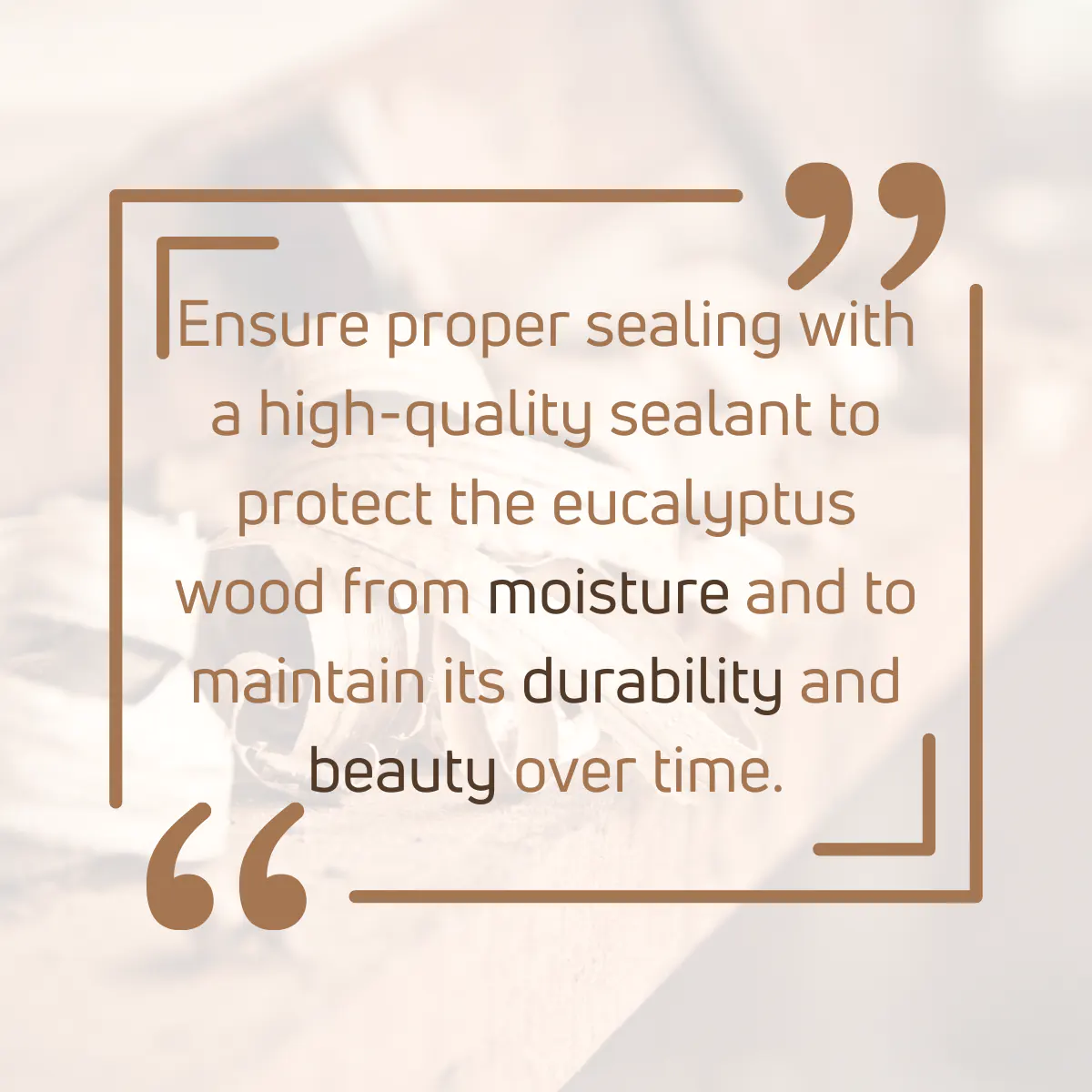
Is Eucalyptus Wood Good for Indoor Furniture?
Yes, Eucalyptus wood is a great option for indoor furniture since it has environmental benefits, durability, and aesthetic appeal.
Let’s explore this in detail.
Sustainability and Environmental Impact
Renewable Resource
Eucalyptus trees are known for their rapid growth, which makes this type of wood a more renewable resource compared to traditional hardwoods.
The quick regeneration rate means that eucalyptus plantations can replenish themselves in a relatively short period, reducing the environmental impact associated with logging.
Eco-Friendly Production
Furthermore, eucalyptus production has a smaller carbon footprint compared to other woods.
The trees require less water and pesticides, making the production process more eco-friendly, which can be a significant selling point for those looking to make environmentally conscious choices.
Durability and Maintenance
Resilient Against Wear and Tear
One of the standout features of eucalyptus wood is its durability.
Furniture made from this type of wood tends to be resilient against wear and tear, holding up well over time.
This can be especially advantageous in pieces like dining tables or sofas, which see a lot of use daily.
Easy Maintenance
Additionally, eucalyptus wood furniture is relatively easy to maintain.
Its smooth surface can be cleaned with a simple mixture of water and mild detergent, helping you keep your furniture looking as good as new for a long time.
Aesthetics and Versatility
Rich Textures and Patterns
Eucalyptus wood is known for its rich textures and patterns.
Its fine grain and a variety of tones can bring a warm and natural aesthetic to your indoor spaces.
From contemporary to rustic, it can complement various styles, adding a touch of elegance and sophistication to your home.
Customizable
Another added benefit is that eucalyptus wood is quite customizable.
It accepts stains and finishes well, allowing you to tailor your furniture to match your existing décor seamlessly.
Whether you are looking for a statement piece or furnishing an entire room, eucalyptus wood offers a sustainable and stylish option.
As a note of caution, always ensure that you source your furniture from reputable manufacturers who adhere to sustainable practices to make the most out of your investment.
Is Eucalyptus a Hardwood?
Yes, Eucalyptus is a hardwood because it is derived from angiosperms, which are trees with enclosed seeds, often in fruits or flowers, which naturally classifies it as a hardwood.
This classification is less about the actual hardness of the wood and more about the botanical family it belongs to.
How Long Will Eucalyptus Wood Last?
Eucalyptus wood lasts for about 25 years with proper care and regular maintenance. But with no care, Eucalyptus wood won’t last for more than 2 – 3 years of use.
Apply quality sealant to keep Eucalyptus wood protected and for enhanced durability.
Proper caring is a must to increase the lifespan of Eucalyptus wood since if the wood does not get attacked by moisture, UV light, temperature variations, or humidity changes, it won’t get easily damaged or weakened.
Apply sealant, wood finish, or wood stain all over the wood at least once per year to keep Eucalyptus wood last for so long.
After 25 years of use better to move on to a new option since Eucalyptus wood is not as durable as teak, mahogany, or cherry wood to have lifetime durability.
Does Eucalyptus Wood Crack?
Yes, Eucalyptus wood gets cracked because of extremely cold weather, extensive expansions, and contractions due to humidity changes, temperature fluctuations, insect and pest attacks, UV light, moisture, and excess drying.
You can prevent Eucalyptus wood from cracking by applying a quality sealant or finisher to increase wood flexibility.
Applying wood finisher-like finishing oil, penetrates deep into the Eucalyptus wood fibers and makes them saturated.
They will increase the flexibility of Eucalyptus wood and prevent the wood from cracking under extreme weather conditions.
Once Eucalyptus wood gets cracked due to any of the above impacts, you can repair wood by applying wood filler or wood putty and applying paint or wood stain on top of that to hide visible marks and get back Eucalyptus wood to its original look.
Even though Eucalyptus wood has excellent natural weather resistance, it gets broken in harsh extreme conditions.
But overall, Eucalyptus wood is great for any project due to its natural resistance.
Is Eucalyptus Wood Good for Anything?
Eucalyptus wood is great for designing projects and outdoor woodworking projects like making bots, structural beams, doors, window frames, patio furniture, flooring, cabinet making, millwork and so much more.
Eucalyptus wood is a versatile wood that can use pretty much for anything. But applying a quality sealant or finisher is a must to keep the wood for so long.
Do Termites Eat Eucalyptus Wood?
Yes, termites love to eat Eucalyptus wood. More than 80% of Eucalyptus trees in Northern Australia got eaten by termites and that is also one of the key reasons for the less availability of quality Eucalyptus wood.
Termites chew and eat Eucalyptus wood using their sharp legs.
They’ll loosen the wood’s stability and strength. Once the termites went inside the wood, they’ll spread quality, and removing them can be extremely difficult.
Even though Eucalyptus wood is moderately termite resistant, under extreme termite populations like outdoors, Eucalyptus wood gets no luck surviving.
You need to treat Eucalyptus wood chemically to prevent it from getting attacked by termites since, harmful chemicals in wood finishes, and wood stains able to kill termites.
Therefore, applying a quality sealant or finisher on Eucalyptus wood is a must especially if you’re willing to place Eucalyptus wood furniture outside to get protected it from termite attacks.
Is Eucalyptus Wood Eco-Friendly?
Yes, Eucalyptus wood is eco-friendly wood. it helps to keep sustainability through carbon sequestration. Having oil is important to get protected from moisture and other elements.
As per research, Eucalyptus wood is 10 times more sustainable than cottonwood.
Because of being so environmentally friendly, Eucalyptus wood is used for large construction projects.
It is non-toxic wood with excellent woodworking properties.
So, let’s answer some frequently asked questions.
FAQs
Is eucalyptus wood prone to warping?
Yes, eucalyptus wood can be susceptible to warping, especially if it is not properly dried and treated before use. This can potentially affect the longevity and aesthetics of the finished product.
Does eucalyptus wood harm the environment?
While eucalyptus trees grow rapidly, their cultivation can sometimes lead to negative environmental impacts, including soil depletion and habitat destruction, if not managed sustainably.
Is eucalyptus wood resistant to pests?
Despite its natural resistance to some pests, eucalyptus wood can still be susceptible to termite attacks, necessitating proactive protective measures to ensure its durability.
Is eucalyptus wood expensive?
The cost of eucalyptus wood can vary; however, it is generally considered to be more affordable compared to other hardwoods. Its price may fluctuate based on quality, origin, and market demand.
Can eucalyptus wood be used outdoors?
While eucalyptus wood can be used outdoors, it may require regular maintenance and protective treatments to prevent damage from environmental elements like moisture and UV rays.
Is eucalyptus wood difficult to work with?
Eucalyptus wood can be somewhat challenging to work with due to its density and hardness. This can make cutting and shaping the wood more labor-intensive compared to other types of wood.
Did I cover all you wanted to know about: Eucalyptus Wood Disadvantages?
In this article, I have deeply discussed 10 Eucalyptus wood disadvantages and how to fix them using simple techniques and tricks.
Eucalyptus wood disadvantages are susceptibility to warping, potential environmental harm due to unsustainable cultivation, vulnerability to pest attacks, and being somewhat challenging to work with due to its hard and dense nature.
Most of the above disadvantages of Eucalyptus wood can be fixed by applying a proper sealant or finisher.
Furthermore, I’ve answered some frequently asked questions as well.
Hope you have gained good knowledge about Eucalyptus wood disadvantages in-depth with easy fixes.
Try Eucalyptus wood for your next woodworking project and try to minimize its cons as discussed and try to get maximum benefits out of it. Happy woodworking with Eucalyptus wood!